
Rayfe Karsan
Journal personnel Journal personnel
Répartition des points de Compétences Répartition des points de Compétences
Cours Généraux: l'Histoire de l'Ordre Cours Généraux: l'Histoire de l'Ordre
- Histoire de l'Ordre: l'Ordre Jed'aii
- Histoire de l'Ordre: l'Ordre Jedi et l'Ancienne République
- Histoire de l'Ordre: Le Nouvel Ordre Jedi
- Le Code Jedi
Cours Généraux: La Force et ses techniques (Padawan) Cours Généraux: La Force et ses techniques (Padawan)
- La Force
- Ressentir la Force
- Sensations de la Force : Les Echos de Force
- Sixième étude des Sensations de la Force : Les Liens de Force
- Sens de l’environnement
- Sens de la vie
- La Détection du danger
- Canalisation des flux énergétiques
- La Télékinésie
- Le saut de Force
- La Célérité
- La poussée de Force
- Le contrôle de la respiration
- L'empathie de Force
- L'étourdissement de Force
- Le crucitorn
- La Théorie des Cercles (Sabre laser/Shii-Cho)
La Force et ses techniques Niveau Chevalier La Force et ses techniques Niveau Chevalier
- La neutralisation de poison
- Postulat : La dissimulation par l'Art du Petit
- Les techniques du Bouclier de Force
- La Télépathie
- La Persuasion
- La Ionisation
- La Psychométrie
- La Lecture de pensées
- La Transe d'hibernation
- La Répulsion
- Jugement Électrique
- Tutaminis
- Flash de Force
- Le pistage de Force
- Le sens de Veshet
- La purge du CO
- L'explosion de Force
- Illusion Mineure
Recherches personnelles Recherches personnelles
- Alchaka (méditation en mouvement)
- Le Sabre laser
- Design sabre laser
- Les cristaux de sabre laser
- Art Anzati
- Méditation ascendante
Styles de combat Styles de combat
- Style de combat au sabre laser
Reconstruction de l'Ordre Reconstruction de l'Ordre
PNJ PNJ
Rapports de Missions Rapports de Missions
Styles de combat
Style de combat au sabre laser
Style de combat au sabre laser
"Suite aux différentes conversations que j'ai eu l'occasion d'avoir avec mon Maître, ainsi qu'aux longues sessions d'entrainement auxquelles j'ai eu l'occasion de participer j'en suis arrivé à la conclusion que mon style de combat reposerait sur une astucieuse combinaison entre la Forme III, le Soresu, la Forme IV l'Ataru et les deux variantes de la Forme V, le Djem So et le Shien."
Voici respectivement les descriptions de chacune des formes susnommées.
Forme III
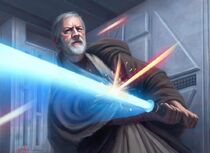
Form III, also known as Soresu, the Way of the Mynock, or the Resilience Form, was the third of the seven classic forms of lightsaber combat that was recognized by the Jedi Council prior to and during the Clone Wars. Soresu was developed during the widespread emergence of blasters as an offensive weapon. Essentially a development on Form I blast-deflect training, Soresu relied on tight bladework and subtle dodges to provide maximum defensive coverage, minimizing exposure to ranged weaponry. Over time, Soresu transcended this basic origin, and came to be considered the ultimate expression of non-aggressive Jedi philosophy.
Like Makashi, Soresu relied on economy of motion and energy efficiency, keeping up constant blade-movement to build up momentum and minimize energy-expenditure. Form III focused on strong defensive technique to essentially outlast an opponent, waiting until he/she began making mistakes due to frustration or fatigue, before taking advantage of these lapses and countering. However, despite its effectiveness, Soresu would receive heavy criticism due to its lack of offensive capabilities, as it facilitated survival rather than victory. As an answer to these weaknesses, the highly aggressive Ataru and Shien forms would be developed side-by-side.
Description
The Soresu form was devised to counter the wide-spread emergence of blasters, a weapon that the previous Makashi form wasn't equipped to combat. The pragmatic Form III became the most defensive of the seven forms, and utilized tight moves, consisting of subtle dodges and efficient parries, intended to provide maximum defensive coverage, and minimize exposure to ranged fire. Over time, Form III came to transcend this basic and pragmatic origin, and became an expression of non-aggressive Jedi philosophy.
Soresu utilized tight motions, lightsaber moving every second in an attempt to achieve near-total protection, and expend as little energy in the process as possible. Form III stressed quick reflexes and fast positional transition, in order to overcome the rapidity with which a blaster could be fired. This technique minimized the body's exposure, making a well-trained practitioner practically invincible, which allowed Soresu to be effective against both single enemies and multiple opponents, as well as blasters and lightsabers. Form III involved preparation for prolonged battles where the user observed and learned as much as possible about their adversary's technique while engaged in combat. Also, being more optimized for lengthy battles, a Soresu user had the ability to gain control of a combat situation, creating multiple options for the Jedi employing the form. A Form III user could choose to kill, disarm, or even reason with their opponent.
The core tenets of Soresu encouraged duelists to place themselves "within the eye of the storm:" to maintain a calm center, undistracted and undisturbed by the conflict around them.[14] In keeping with this idea, Soresu incorporated powerful defensive techniques that were flexible enough to adapt to almost any circumstance, at the cost of never reaching past the figurative "eye of the storm." In other words, Soresu focused almost entirely on self-defense, often at the expense of offensive capabilities. The tactics encouraged by the style involved the reliance on pure defense while essentially waiting out the opponent, holding back until his frustration or fatigue inevitably caused his defense to lapse, then employing an alternate, more aggressive attack to take advantage of this. Overall, the whole point of Soresu was to deflect blaster fire out of harm's way and safely prolong a lightsaber fight in hopes of wearing an opponent down.
Truly focused masters of Soresu were extremely formidable due to their strong defensive technique, as well as the well-rounded nature of the form itself, effective against both blasters and lightsabers. However, it should be noted that Form III facilitated survival rather than victory, as Soresu possessed no dedicated offensive sequences of its own. Form III initiates were more than capable of defending themselves from attack, but they needed a considerable amount of experience to learn how to effectively counter-attack and entrap opponents. Masters had to maintain an incredibly strong focus on the center of the combat circle, since the defensive tactics of the form included guards and parries that engaged very close to the body. Jedi with small lapses in their otherwise strong defense left little room to avoid injury. As a result of this defensive mindset, Soresu practitioners often had a great deal of difficulty in seizing the offensive initiative in combat situations. Also, the goal of many Soresu practitioners was to prolong the fight, the idea being to cause the enemy to become fatigued or frustrated as they attempted to keep up their offense. However, this tactic ran the risk of fatiguing the user if said user was to face an adversary who could maintain an aggressive but cautious offense.
Known moves and manoeuvers
For the Soresu opening stance, the duelist held the blade back in a one-handed grip, angled forwards with the left arm held parallel, the off-hand held up in a challenge. The dominant foot was positioned back.[9] The brace-ready stance had much in common with the "Ataru guard," with the hilt held at waist height on the dominant side in a two-handed grip for greater control, extended vertically upwards. The dominant foot was placed back while the other was extended forwards and to the side in a brace-position. A variation on this stance featured the blade held high in a drop-parry position, though the foot positions were the same.
Against individual shooters, Form III duelists were encouraged to apply the "deflecting slash". This move served the dual purposes of allowing a Jedi to redirect the momentum generated by deflecting an enemy projectile into a slashing attack at an adjacent target, and allowing the Jedi to advance and close the distance before the attacker could fire off another shot. A careful application can allow a Jedi to redirect the shot back at the attacker, though this skill is more commonly applied by Shien practitioners. Against multiple blaster-wielding attackers, the "circle of shelter" was advised. This technique could allow a Soresu practitioner to hold off as many as twenty shooters by dropping into a moving meditation, relying on the Force to perceive the various positions of the attackers and the necessary movements to evade or deflect their shots. As this maneuver was executed while in a meditative state, prolonged use may open a Force-adepts mind to visions of the future.
Applications
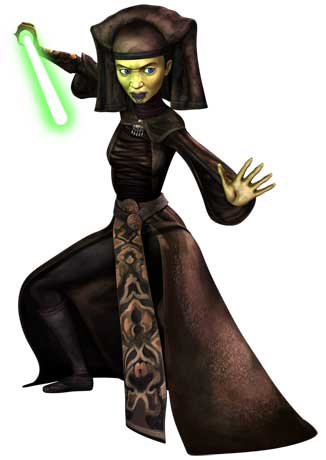
When Darth Bane first began training Zannah as his apprentice, he pragmatically judged that her small size and light build removed the more aggressive lightsaber forms from her potential repertoire. Teaching her to wield a saberstaff, he trained her to redirect an opponent's attacks rather than directly blocking in order to maintain her own energy. She took to twirling her weapon in order to maintain momentum and to set up a defensive shield against enemy attacks.[4]
In combat, Zannah also relied just as much on tactical know-how as lightsaber skills. As evidenced during the Duel on Tython, Zannah sought out strategically advantageous positions on the field, able to make do with a simple room corner, using the two walls to cover her flanks. Also, she was skilled at playing her opponents against one another, allowing lesser combatants to continue fighting in order to inadvertently hinder their fighting partners, as when she played Johun Othone against Sarro Xaj. However, Zannah was not without her weaknesses; her defense was designed to counter against all-out assaults, a method devised from her experience sparring with Darth Bane. Sarro Xaj's powerful attacks were tempered by caution, and Zannah was forced to expend huge amounts of energy to fend him off without finding any openings for her to exploit. She only succeeded in killing her opponent because he was momentarily distracted.
Obi-Wan Kenobi originally specialized in Form IV, trained in the form by Qui-Gon Jinn. However, upon witnessing his master's death due to Ataru's lack of defensive capabilities, Kenobi decided to switch his focus to Soresu in order to eliminate this weakness in his own technique.[10] Kenobi's resulting skill in Form III stood him in good stead against masterful gunslingers such as Jango Fett, or during the chaotic firefight on Geonosis. His tight defense and energy-efficient moves enabled him to pull through and survive where most of the Jedi strike team could not.[19] However, when confronting Dooku, Kenobi's skill in Soresu was insufficient to effectively counter Dooku's mastery of Form II lightsaber combat. Though Kenobi was a skilled Soresu practitioner, he was unable to match Dooku's precision and economy of motion. During their duel, many of Kenobi's cutting parries outright missed Dooku's blade, forcing Kenobi into numerous scramble situations and rapidly fatiguing him. Kenobi was ultimately brought down by light, incapacitating cuts across his left arm and leg.
Over the course of the Clone Wars, Kenobi continued to develop his skills. His blast-deflection technique advanced to the point where Kenobi could walk "unscathed through hornet-swarms of blasterfire." Kenobi's skill as a lightsaber duelist also improved considerably, developed by thousands of hours in lightsaber sparring with Anakin Skywalker and others,[5] and hardened by numerous engagements with enemy duelists, such as General Grievous, Asajj Ventress, and even Dooku himself.[21] Even unarmed, Kenobi was a formidable opponent, evading enemy attacks and working his way inside an opponent's defense to physically assault them, demonstrating this tactic against the likes of Ventress and Pre Vizsla.[22][23]
By the end of the war, Kenobi's mastery of Soresu had developed to the point where he could compete with Dooku. In their final duel with Dooku aboard the Invisible Hand, Kenobi and Skywalker both initially utilized basic lightsaber techniques and strategies, aiming to lull Dooku into a false sense of confidence.[14] When they suddenly shifted to the advanced fighting methods they had practiced and developed during the interim, Kenobi displayed his full mastery of Soresu. Dooku was astounded by the simplicity and efficiency of his bladework, but also his bewildering speed and precision. Caught off-guard and forced to retreat, Dooku only succeeded in defeating Kenobi thanks to his superior mastery of the Force. In his final duel with Grievous, Kenobi provided one of his purest demonstrations of Soresu. His blade's intricate pattern of blocks and parries moved just fast enough to subtly interfere with Grievous' multiple strikes, while his slight dodges and shifts of stance facilitated his evasion of the rest. As a frustrated Grievous ramped up the intensity of his assault, Kenobi countered by altering the angle of his parries, clipping off two of Grievous' mechanical wrists. However, it should be noted that Grievous had been badly injured by Mace Windu during the Battle of Coruscant and had had virtually no time to recuperate before facing Kenobi, which may have contributed to Kenobi's victory. Kenobi proved to be one of the only Jedi able to engage Darth Vader and emerge victorious, as his Soresu mastery perfectly countered Vader's angry Form V. Kenobi simply deflected and blocked Darth Vader's relentless rain of blows, returning counter-blows himself to disrupt Vader's onslaught, all the while guiding the battle to a location of his choice, before finally dismembering the hapless and enraged Sith Lord when his defense lapsed.
However, during to his long isolation on Tatooine, Kenobi's skills as a swordsman atrophied, as he engaged in only one lightsaber duel during his entire period of exile. Despite this, he remained a formidable Form III practitioner, and he was able to hold off Darth Vader for a short time during their rematch aboard the Death Star. However, unlike their bout on Mustafar, Vader maintained a cautious, controlled offense instead of a reckless onslaught, and Kenobi was unable to find any openings to exploit. As a result of Vader's alterations to his technique and his own advanced age, Kenobi tired rapidly, and ultimately chose to sacrifice himself in order to distract Vader from his fleeing compatriots.[10]
The key to truly mastering Soresu seemed to come from grasping the concepts and philosophy of the form rather than adhering to its tactics and maneuvers. While Kenobi displayed a strong preference for Soresu, he continued to apply elements of the relentlessly dogged Form I as well as the erratic strokes and acrobatics of Ataru. At one point just before the conclusion of the Clone Wars, Mace Windu acknowledged Obi-Wan Kenobi as "the master of Soresu.
Liste des mouvements utilisés:
Circle of Shelter: A technique where the duelist creates a protected area around themselves and their allies, making it difficult for enemies to penetrate.
Deflecting Slash: A technique where the duelist redirects the momentum generated by deflecting an enemy projectile into a slashing attack at an adjacent target.
Forme IV
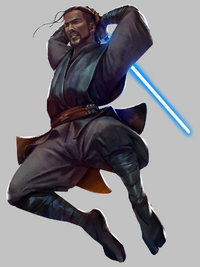
Overview:
Form IV, also known as Ataru, the Way of the Hawk-Bat, or The Aggression Form, was the fourth of the seven forms of lightsaber combat. The history of Ataru stretched back through the Old Republic, to at least as early as the Mandalorian Wars, where it was commonly employed by Jedi of that day. Ataru continued to be a common form among the Jedi in the latter stages of the Republic, and was also known to be employed by the Sith.
An aggressive style, Form IV was fast-paced and effective against single opponents, though weaker in prolonged combat and confined spaces. Also, it was not recommended for use against opponents wielding blasters. Ataru was characterized by Force-assisted acrobatics, such as somersaults and leaping strikes, both for attack and defense. Another characteristic of the form was its fast, powerful strikes from multiple directions. Notable users of this combat form during the Old Republic included Yoda and Qui-Gon Jinn. The New Jedi Order preserved knowledge of Ataru, and Jedi Masters such as Luke Skywalker, Mara Jade Skywalker, and Kyle Katarn all employed it.
Description
Ataru was an aggressive combat form relying on a combination of strength, speed, and agility. Due to this, it was also called the Way of the Hawk-bat or the Aggression Form. Practitioners of Ataru were always on the offensive, attacking with wide, fast, and powerful swings. Form IV practitioners constantly called upon the Force to aid in their movements and attacks. By allowing the Force to flow throughout their body, they could overcome their physical limitations—including old age, as was the case with Master Yoda—and perform amazing feats of acrobatics, such as somersaults and backflips, not only for attack, but also to evade the slashes and strikes of their opponents.[1] Jedi utilizing Ataru needed to incorporate all the Force powers that involved surpassing normal physical ranges of motion, speed, and agility in order to be successful. Running, jumping, and spinning were all emphasized in learning the elaborate kinetics of the form.[15]
Those who used Form IV could move at high speeds and could rain strong blows, jumping and attacking through the air. Powerful and quick spinning attacks could be utilized from all angles, either from ground or air. Masters of Ataru combat could appear like a blur to their opponents, attacking from all directions—the front, the sides, overhead, or behind. The Force not only allowed them to perform athletic feats not possible otherwise, but it also helped guide their actions and movements in combat.[1]
Applications

Ataru proved to be an effective combat form when used properly, and was common among Jedi during the Mandalorian Wars. It was well-suited to close combat, particularly against single opponents.[3] Due to its speed and agility, Ataru was recommended for use by Jedi with the ability to enhance their speed and stamina with the Force.[16]
DotF TPM
Qui-Gon Jinn and Obi-Wan Kenobi utilize Ataru against Darth Maul's Juyo on Naboo.
Because it was such an aggressive style, Ataru was not generally optimal for use against multiple opponents, and it was somewhat ineffective against blaster fire, particularly from multiple foes.[3] Despite those weaknesses, Jedi Padawan Obi-Wan Kenobi and Jedi Master Qui-Gon Jinn were able to employ this form with great success during the Battle of Naboo against numerous B1 battle droid opponents.[17] This form was also considered not as effective for prolonged combat, as the nature of Ataru could greatly tax the body. Ataru practitioners were advised to withdraw if they were unable to win after a devastating burst of Ataru attacks.[16] Fatigue was theorized to have been a contributing factor in Qui-Gon Jinn's defeat on Naboo at the hands of Sith Lord Darth Maul during the latter stages of the Battle of Naboo. In fact, ever since their brief fight on Tatooine, Maul knew that Ataru would be the Jedi Master's undoing.[18][19] Another contributing factor in Jinn's death was the requirement of open space for the kinetic acrobatics of Ataru. Without ample space to move in the Theed Royal Palace reactor core, Jinn was deprived of the key element in his defense, and thus could only attempt to block Maul's incessant barrage of Form VII strikes. This event influenced Kenobi—after his Master's death, he changed his preferred form to Soresu, the most defensive of all forms.[1]
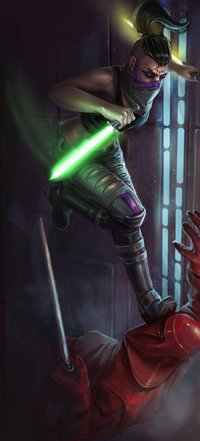
A female Jedi attacks an Emperor's Royal Guard using the Hawk Bat Swoop.
Through the Force, Yoda was considered to have mastered Form IV to its highest level. He used it in almost all of his battles, and his mastery of the style caused others to describe him as virtually unstoppable against most opponents, including Separatist battle droids, despite his small size and advanced age. His moves in his duel against Count Dooku on Geonosis during the Battle of Geonosis were revealed on close examination to be a fast-paced demonstration of the standard components of Form IV. Each action flowed from one to another in the smooth transitions characteristic of Form IV. In addition, three kinds of rotation, called su ma, figured prominently in his style: jung su ma (spinning), ton su ma (somersaults), and en su ma (cartwheels). These three moves represented the three possible axes of rotation in three-dimensional space. Together with Force-enhanced jumps, the rotational su ma moves composed most of his style, making the Grand Master exemplary of Form IV mastery.[1] At one point prior to the Clone Wars, Yoda was known to give demonstrations of the form in use, some of which were recorded on data books in the Jedi Temple.[15] Yoda also employed Ataru against the clone troopers on Kashyyyk and Coruscant at the conclusion of the Clone Wars when the Jedi Purge began. Despite its weaknesses to blaster fire and multiple opponents, Yoda's mastery of the form was such that he was able to defeat the clones.[20]
Dooku stated that he understood "every weakness of the Ataru form, with its ridiculous acrobatics," given his many sparring sessions with Qui-Gon Jinn. Dooku's Form II would counter Ataru by launching a series of thrusts toward the enemy's legs to draw the opponent into a flipping overhead leap, so that Dooku could burn through the enemy's spine from kidneys to shoulder blades with his Makashi attack. The Count applied this tactic against Obi-Wan Kenobi, who blocked Dooku's blows with Soresu, on board the Separatist flagship Invisible Hand during the Battle of Coruscant.
Known moves and manouvers
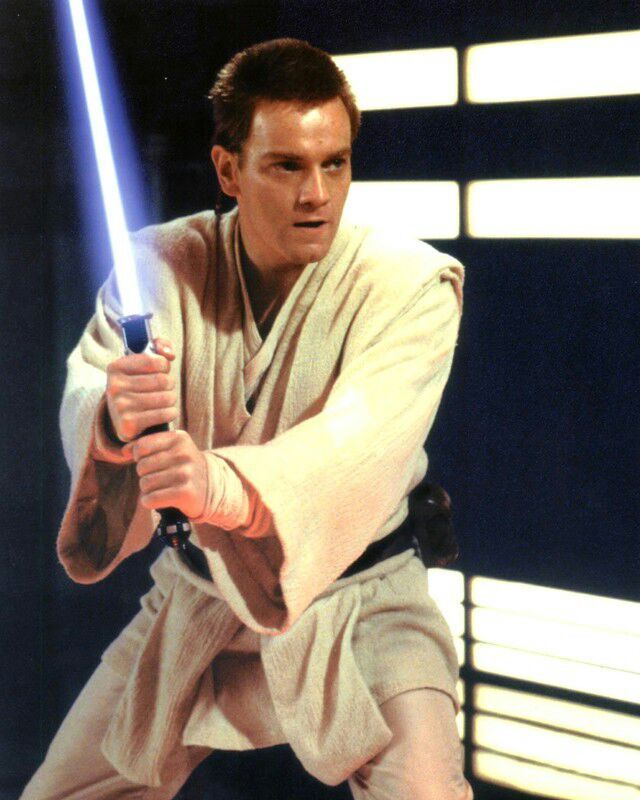
The opening stance for Ataru was a balanced two-handed guard: holding the lightsaber vertically with both palms, either on the right or left side of the body.[21] One technique employed with greater effect by Ataru users was the Hawk-Bat Swoop. When utilized by Ataru practitioners, it was intended to allow a combatant to quickly strike their opponent without giving them a chance to react, and then escape before they had a chance to retaliate. Another move that Ataru users could use effectively was dubbed the Saber Swarm, where numerous short strikes were aimed at the adversary to force a defensive posture.[16] Ataru wielders were able to execute this combination with particular skill.[2] Both the Hawk-Bat Swoop and the Saber Swarm were related to the Falling Leaf technique, and they gained in popularity during the New Sith Wars.[16]
Liste des mouvements
- Technique de la feuille morte ou feuille tombante;
- Le Swoop du chauve-faucon : attaque suivie d'un vif retrait;
- Jeu de jambes du Su Ma;
- Jung Su Ma : tournoiement;
- Ton Su Ma : saut périlleux;
-En Su Ma : la roue;
Forme V
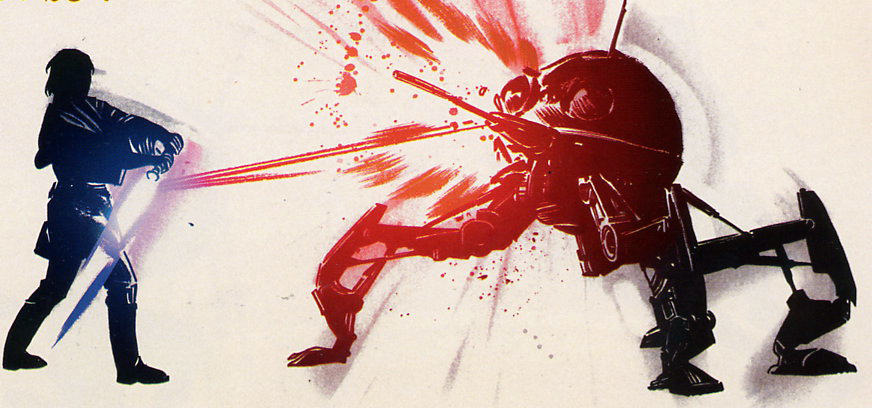
Overview:
Form V, also known by its two primary disciplines of Shien and Djem So, as well as The Way of the Krayt Dragon or The Perseverance Form, was the fifth of seven forms recognized as canon by the last Jedi Council for lightsaber combat. It was developed by practitioners of Form III who felt that the defensively-minded form would unnecessarily extend time spent in combat by forcing its users to wait for an opportunity to strike rather than create their own openings. Form V combat was characterized by power attacks and defense immediately followed by a counter-strike.
Shien, considered the classical variant of Form V, was more adept at blocking blaster bolts than for blade-to-blade combat, whereas Djem So was developed later and was specifically intended for use in lightsaber combat. Both Shien and Djem So were designed to use an opponent's attack against them, as evidenced by Shien's focus on returning blaster bolts to their origin and Djem So's emphasis on immediate counter-attacks. Although some Jedi felt that Form V encouraged aggression and domination, that sentiment did not stop many Jedi from practicing the form.
Form V was developed sometime prior to the Great Sith War, which began in 3996 BBY, and it continued to be used for millennia, during the Jedi Civil War, New Sith Wars, Clone Wars, and beyond. Like the other lightsaber forms, it saw use among both the Sith and Jedi. Knowledge of the form survived the Great Jedi Purge initiated in 19 BBY and into the era of the New Jedi Order. Practitioners of Form V included Jedi Masters Plo Koon and Luke Skywalker, Jedi Knights Anakin Skywalker, Aayla Secura, and Ulic Qel-Droma, and Dark Lord of the Sith Darth Bane.
Description
Form V, also known as the Way of the Krayt Dragon, was created by Form III masters who desired a more offensive style, since the defensive nature of Form III often led to prolonged combat, which was potentially dangerous for its practitioners. Form V evolved into an accepted style by combining the defensive maneuvers of Form III with the more aggressive philosophy and tactics of Form II. Form V required a higher level of physical strength than the other lightsaber forms, due to its focus on complete domination of its practitioners' opponents. It was considered the most physically demanding of all the forms.
The form was developed alongside Ataru at a time when the Jedi were increasingly called upon to actively keep the peace. Some Jedi, noting its dedication to domination and strength, felt that Form V encouraged an inappropriate focus on controlling one's assailants. Other Jedi, including the Jedi battlemaster Cin Drallig, were somewhat ambivalent regarding the form. Nevertheless, the Form's proponents maintained that Form V was an effective and powerful tool for the Jedi Order. Form V had two distinct variations: Shien and Djem So, and most users had a preference for one or the other.
Shien:
The Jedi of the Old Republic who developed and employed the classical Form V variant Shien dubbed it the Perseverance Form. Shien was described as being well-adapted to guard against blaster fire and enemy strikes without compromising one's ability to launch powerful counterattacks. The style worked best when countering attacks from multiple opponents, and was typically less effective against a single adversary. Shien existed at least as early as the Jedi Civil War, which began in 3959 BBY. With its focus on repelling blaster fire, Shien kept in mind that Jedi were often outnumbered by their opponents and needed to defend themselves while retaining offensive capability. Additionally, there was a Sith variant of the form called Sith Shien, though it is not specified how this form might have differed from it's Jedi counterpart.
The Shien opening stance was a high guard position, with the lightsaber hilt held in a two-handed grip above the user's head and the blade angled upward and behind the user. The dominant leg was held back, enabling powerful step-through strikes to be utilized. Shien users were also proficient in a maneuver referred to as the "Barrier of Blades," which defended the user from blasterfire and redirected some of the incoming blasts. "Shien Deflection" was another technique familiar to users of that Form V variant, allowing practitioners to simultaneously deflect weapons fire and leap toward an opponent. However, Shien was not without its shortcomings—it was particularly weak against a single opponent.
Some users used the reverse Shien grip, an unorthodox variation of Shien where the wielder would hold the lightsaber hilt in a backward position, exposing the front. This grip allowed the user to perform long, sweeping strikes to take down several enemies at a time, whipping the blade forward with the movement of throwing a punch. This variation was rarely seen and, indeed, almost a matter of controversy among lightsaber masters.
Djem So
Djem So was the creation of a group of Form III masters who felt that Soresu was too passive a form. It addressed the shortcomings of Form III, in which a Jedi Master could maintain a prolonged defense but was likewise unable to overcome a skilled opponent. Utilizing a combination of blocks and parries, a Djem So user maintained a proper foundation of defense against both ranged and melee attacks. While a Soresu user stayed on the defensive and only counterattacked when necessary or when an opening appeared in the opponent's defense, a Djem So practitioner was not as passive. Immediately after defending against an opponent's strike, a Djem So stylist followed with an attack of their own, bringing the force of the opponent's own blow against them and seeking to dominate the duel. Djem So placed a heavy focus on brute strength and pure power, with wide, powerful strikes and parries followed immediately by a counterattack.
Unlike Soresu or Ataru, Djem So required the user not only to counterattack, but also to press the assault, combining Force-enhanced strength with powerful blade combinations to overpower and overwhelm an opponent's defenses. Djem So's sheer power, when combined with physical and Force-imbued strength, was capable of defeating a user of Makashi, a lightsaber form focused on dueling, finesse, and elegance, when employed by a skilled practitioner.
The Djem So attack stance consisted of holding the lightsaber above the head, angled back and down at an approximately forty-five-degree angle. The characteristic Djem So attack was dubbed the "Falling Avalanche," an overhand power blow that crashed down upon an opponent with exceptional force. Djem So users also employed a tactic known as the "Fluid Riposte, which involved a smooth transition from parrying an attack to a counterstrike. Whereas a failing of Shien was its weakness against a single opponent, Djem So was known for having a lack of mobility.
Application:
Jedi of large stature often chose to use Form V, because it required less agility than other forms of lightsaber combat and made use of their natural strength and reach advantages. It was for this reason that the Sith Blademaster Kas'im advised the Sith apprentice Bane to learn Djem So. Bane's imposing size and strength served to complement the form; his power attacks were able to knock his opponents back just through sheer kinetic force, throwing them off balance and leaving them vulnerable to further brute-force strikes and power blows that sought not just to penetrate his opponents' defense, but also to push them back and leave them unable to counter blows. However, Anakin Skywalker later commented that all Jedi could enhance their strength with the Force and thus make use of Form V.
Jedi Padawan Anakin Skywalker initially employed Shien in his duel against the Sith Lord Dooku on the planet Geonosis, although he later employed Form IV while wielding two blades. Once Dooku managed to destroy one of the weapons, Skywalker was forced to revert to his Form V practices. While his skill enabled him to hold his own against Dooku, he was unable to overcome the Count's elegant Form II bladework, and was defeated. The many engagements of the Clone Wars, against both mechanical opponents as well as lightsaber-wielding Dark Jedi, honed Skywalker's skills. During his final match against Dooku aboard the Separatist Flagship Invisible Hand, Skywalker deceived the Sith with a Shien opening stance and Ataru acrobatics, but during the duel he returned to his own preferred Djem So strokes. The Sith Lord was barely able to deflect the Jedi Knight's blows and was eventually scorched when his own blade was forced back onto his shoulder. Using Form V, Skywalker pushed Dooku back with powerful blows, bolstered by use of rage in the fight, until he eventually disarmed and killed the Sith.
After turning to the dark side in 19 BBY, Anakin Skywalker, now known as Darth Vader, dueled and was nearly killed by his former Jedi Master, Obi-Wan Kenobi, on the planet Mustafar. Afterward, Vader employed a new variant of Form V, even more focused on sheer power, in his service to the dark side and quest to destroy the Jedi. His defeat on Mustafar and subsequent internment in life-support armor forced him to alter his style into a new conglomeration: and he incorporated elements of Form VII, Form IV, Form III, and Makashi into his fighting style. Vader again employed Form V on the Death Star against his former master in their final duel—but rather than continuing to fight, Kenobi sacrificed himself. Eventually, the same techniques used by Vader against Kenobi were mirrored and used against him by Vader's son, Luke Skywalker.
In Cloud City on Bespin, Luke Skywalker was able to hold his own against Darth Vader for a time, despite his minimal training. Ultimately, unable to stand against Vader's aggressive barrage, Skywalker was driven back and disarmed, losing his hand. After the duel, Skywalker further studied lightsaber skills that he found in a journal left to him by Obi-Wan Kenobi and advanced his abilities. Later, aboard the second Death Star, Luke was able to duel Vader on an even footing, mirroring Vader's Form V technique. When Vader attempted to taunt Skywalker by suggesting that he would tempt Skywalker's sister to join the dark side, the tactic provoked the Jedi into a fury, and in that state he was able to defeat the experienced Sith Lord. Skywalker responded to Vader's aggressive usage with his own furious demonstration of Form V technique, defeating the experienced Sith Lord before refusing to continue the fight. Later, Skywalker would comment that Form V needed to have its aggression and desire to dominate balanced with compassion.
At times, other weapons beyond standard lightsabers were wielded effectively by Form V practitioners. For example, Dark Lord of the Sith Darth Bane wielded a curved-hilt lightsaber—a weapon traditionally associated with Form II. Bane noted that curved lightsabers fit better into the palm, allowing greater power without costing precision. They also altered the angle of attacks slightly, which gave Bane a unique dueling style. Other weapon types wielded by Form V practitioners include lightsaber pikes, as shown by the Shien practitioner Kazdan Paratus, and saberstaffs, as utilized by the Jedi Master Zez-Kai Ell.
Philosophie:
Le Djem So repose sur la volonté d'un individu à mettre rapidement à un terme à un combat par une puissance de feu supérieure. Bien que considéré comme brutal par la plupart des Jedi. Le Djem So est en réalité tout le contraire. Le Schéma d'attaques de bases du Djem So consiste à briser les defenses de l'adversaire. Sa philosophie est d'autant plus loyale envers l'adversaire dans la mesure où l'on attaque de front. Sous certains aspects elle peut même apparaitre comme une forme de toture émotionnelle puisque l'on harcele les defenses de l'adversaire jusquà ce que celui ci déclare forfait. Certains disent que de cette philosophie tend vers la domination des autres d'ou son potentiel corrupteur mais je ne suis pas tout à fait d'accord en ce qui me concerne. L'intérêt du Djem So réside dans la volonté du bretteur à vouloir mettre un terme à l'affrontement rapidement.
La clef pour maitriser le style, ses codes et sa philosophie réside dans l'équilibre entre vigueur, force et fluidité dans l'execution du mouvement. Ce n'est qu'une fois cet équilibre toruvé que l'on parvient à maitriser pleinement ce style.
Liste des mouvements utilisés:
Flowing water
The Flowing Water cut was a technique based on the principle of using the space created when the opponent withdrew their lightsaber offensively to one's own advantage. As the opponent pulled their lightsaber back from a bind, the user would follow it with their blade, in effect causing the opponent to pull the user's blade into themselves.
Falling leaf
The Falling Leaf cut was an ancient move that involved the user spinning and making a fast slash at an opponent standing behind them and then return to face the way they were before the maneuver. It was described as spinning one's feet to "slash from the sky"
Barrier of Blades: Defended the user from blasterfire and redirected some of the incoming blasts.
Falling Avalanche: An overhand power blow that crashed down upon an opponent with incredible force.
Fluid Riposte: A smooth transition from parrying an attack to a counterstrike.
Shien Deflection: Simultaneously deflect weapons fire and leap towards an opponent.